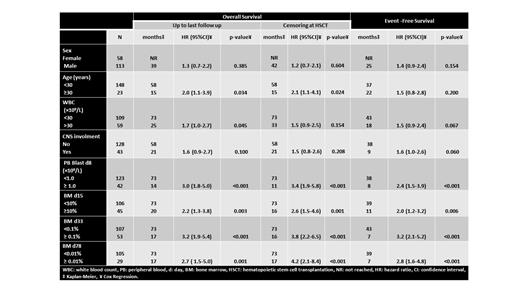Abstract
Background: ALL in adults is considered a heterogeneous disease with poor prognosis. However, adolescents and young adults (AYA) display intermediate characteristics as compared with children. Risk groups and response predictors are essential to guide the treatment.
Aims: The aim of this report was to evaluate the experience of Ph-negative ALL in AYA patients (pts) treated with the pediatric Argentine type-BFM protocol, assessing predictors of response in terms of overall survival (OS) and event-free survival (EFS).
Methods: We performed a retrospective multicenter analysis of AYA pts diagnosed between 2013 to 2021, from 16 Argentine institutions who were treated following the pediatric Argentine type-BFM protocol. Response to prednisone (PR) at day(d) 8 (<1.0 and ≥1.0 x10 -9 blasts) in peripheral blood (PB) and complete remission (morphological remission -MCR- together with negative minimal residual disease -MRD- by flow cytometry) were evaluated. Events were defined as relapse, refractoriness or death. Chi2/Fisher's exact test, Kaplan-Meier / log rank test and Cox regression were used for statistical analysis.
Results: One hundred and seventy-three patients similarly distributed among private and public institutions were analyzed. The median (Md) age was 22 years (15-40) with a male predominance (66%). At diagnosis, 23% presented central nervous system (CNS) involvement, 79.5% B and 20.5% T immunophenotype, 29% CD20 positive, 16% adverse cytogenetic/molecular findings and 29% no data. Ph-like screening was not routinely performed assessed only in 13% revealing two CRLF2 and one PDGFRB rearrangements. Twenty-one (12%) of pts underwent allogeneic bone marrow transplantation (Allo-HSCT) at 1 st line, 20 with MRD negative and 1 MRD positive at the time of the procedure.Of 171 pts, 155 (91%) achieved MCR, 12 (7%) were refractory, 3 (2%) died prior/during induction and 1 (0.6%) patient dropped out of treatment; 144 (84%) achieved negative MRD, 22 (13%) positive MRD and 5 (3%) were not evaluated. The Md to reach CR and MRD (-) was 33d (IQR 31-42) and 35d (IQR 32-73), respectively. With a Md follow-up of 16 months (1-79), 52 pts (30%) relapsed and 68 pts (39%) died. Early deaths at 3 months occurred in 8 (5%) pts, 5 related to treatment and 3 to disease. The Md OS and EFS were 58 and 34 months, respectively. Prognostic predictors analyzed were sex, white blood counts (WBC) at diagnosis (limit of 30 x10 -9/L), age (limit of 30 years), CNS involvement, cytogenetic/molecular findings, PR at d8, MRD in bone marrow (BM) at d15, 33 and 78. In the univariate analysis, response at d8, MRD at d15, 33 and 78 were useful to predict both OS and EFS, adding age and WBC in terms of OS. Similar results were obtained when patients who underwent Allo-HSCT were censored at the time of the procedure. (Table). In the multivariate analysis, positive MRD at d33 and d78 (and WBC in OS) maintained their independent adverse prognostic impact in relation to OS and EFS.
Allo-HSCT showed benefits in pts with MRD >0.1% at d33 and >0.01% at d78 in terms of OS (d33: NR vs. 11 m, p =0.048, HR 0.3, 95%CI [0.1-0.9]; d78: NR vs. 8 m, p =0.009, HR 0.4, 95%CI [0.2-0.8]) and EFS (d33: NR vs. 6 m, p =0.022, HR 0.2, 95%CI [0.1-0.8]; d78: NR vs. 5 m, p =0.003, 0.1 HR, 95%CI [0.02-0.5]). The adverse risk of positive MRD at day 33 and 78 in terms of OS and EFS was overcome when pts were transplanted.
Summary/Conclusion: The results show that positive MRD at d33 and 78 independently impacted on OS and EFS in our series and that Allo-HSCT overcame their adverse risk. Our data confirms the relevance of using pediatric protocols in AYA. On the other hand, the importance of prognostic tools in order to improve the outcome of AYA patients, reinforcing their inclusion in current guidelines.
No relevant conflicts of interest to declare.


This feature is available to Subscribers Only
Sign In or Create an Account Close Modal